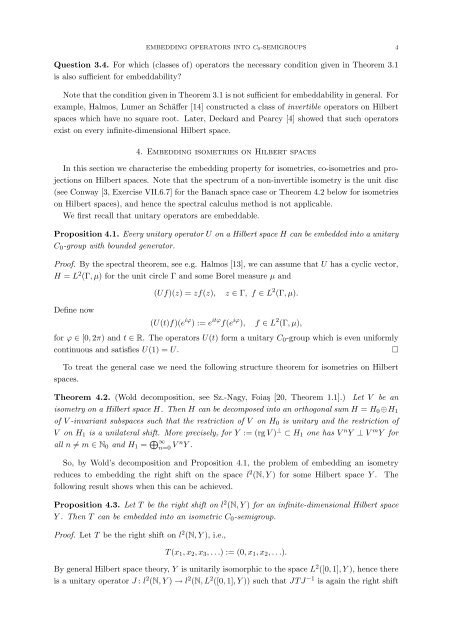EMBEDDING OPERATORS INTO STRONGLY CONTINUOUS ...
EMBEDDING OPERATORS INTO STRONGLY CONTINUOUS ...
EMBEDDING OPERATORS INTO STRONGLY CONTINUOUS ...
You also want an ePaper? Increase the reach of your titles
YUMPU automatically turns print PDFs into web optimized ePapers that Google loves.
<strong>EMBEDDING</strong> <strong>OPERATORS</strong> <strong>INTO</strong> C 0 -SEMIGROUPS 4<br />
Question 3.4. For which (classes of) operators the necessary condition given in Theorem 3.1<br />
is also sufficient for embeddability?<br />
Note that the condition given in Theorem 3.1 is not sufficient for embeddability in general. For<br />
example, Halmos, Lumer an Schäffer [14] constructed a class of invertible operators on Hilbert<br />
spaces which have no square root. Later, Deckard and Pearcy [4] showed that such operators<br />
exist on every infinite-dimensional Hilbert space.<br />
4. Embedding isometries on Hilbert spaces<br />
In this section we characterise the embedding property for isometries, co-isometries and projections<br />
on Hilbert spaces. Note that the spectrum of a non-invertible isometry is the unit disc<br />
(see Conway [3, Exercise VII.6.7] for the Banach space case or Theorem 4.2 below for isometries<br />
on Hilbert spaces), and hence the spectral calculus method is not applicable.<br />
We first recall that unitary operators are embeddable.<br />
Proposition 4.1. Every unitary operator U on a Hilbert space H can be embedded into a unitary<br />
C 0 -group with bounded generator.<br />
Proof. By the spectral theorem, see e.g. Halmos [13], we can assume that U has a cyclic vector,<br />
H = L 2 (Γ, µ) for the unit circle Γ and some Borel measure µ and<br />
Define now<br />
(Uf)(z) = zf(z), z ∈ Γ, f ∈ L 2 (Γ, µ).<br />
(U(t)f)(e iϕ ) := e itϕ f(e iϕ ), f ∈ L 2 (Γ, µ),<br />
for ϕ ∈ [0, 2π) and t ∈ R. The operators U(t) form a unitary C 0 -group which is even uniformly<br />
continuous and satisfies U(1) = U.<br />
□<br />
To treat the general case we need the following structure theorem for isometries on Hilbert<br />
spaces.<br />
Theorem 4.2. (Wold decomposition, see Sz.-Nagy, Foiaş [20, Theorem 1.1].) Let V be an<br />
isometry on a Hilbert space H. Then H can be decomposed into an orthogonal sum H = H 0 ⊕H 1<br />
of V -invariant subspaces such that the restriction of V on H 0 is unitary and the restriction of<br />
V on H 1 is a unilateral shift. More precisely, for Y := (rg V ) ⊥ ⊂ H 1 one has V n Y ⊥ V m Y for<br />
all n ≠ m ∈ N 0 and H 1 = ⊕ ∞<br />
n=0 V n Y .<br />
So, by Wold’s decomposition and Proposition 4.1, the problem of embedding an isometry<br />
reduces to embedding the right shift on the space l 2 (N, Y ) for some Hilbert space Y . The<br />
following result shows when this can be achieved.<br />
Proposition 4.3. Let T be the right shift on l 2 (N, Y ) for an infinite-dimensional Hilbert space<br />
Y . Then T can be embedded into an isometric C 0 -semigroup.<br />
Proof. Let T be the right shift on l 2 (N, Y ), i.e.,<br />
T(x 1 , x 2 , x 3 , . . .) := (0, x 1 , x 2 , . . .).<br />
By general Hilbert space theory, Y is unitarily isomorphic to the space L 2 ([0, 1], Y ), hence there<br />
is a unitary operator J : l 2 (N, Y ) → l 2 (N, L 2 ([0, 1], Y )) such that JTJ −1 is again the right shift
















